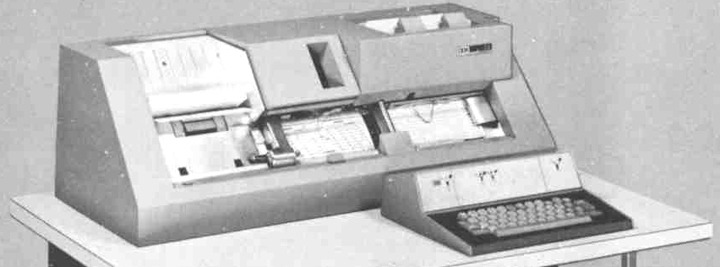IBM Key Punches

Columbia's Herman Hollerith pioneered punch card computation beginning in the late 1880s, when he chose punched cards as the medium for encoding and storing demographic data for the 1890 US Census, based on the ability to use a card as a "record" for each person, with sufficient capacity to hold all the needed information, and to rearrange the records into different orders or groupings without losing information. (Punched cards had first been used in the 1700s for controlling textile looms.)
At first cards were punched by hand, like railroad tickets. Soon Hollerith perfected a device to place punches in a precise grid arrangement. This was called the Pantographic Card Punch. Like the railroad punch, it punched one hole at a time, in the row and column selected by the operator, but with greater accuracy and less strain, and furthermore it allowed uniform access to the entire card, not just the parts near the edges.
In 1901 Hollerith patented his first key punch, a card punch machine that was operated by keys, like a typewriter, and that advanced the card automatically to the next column after each punch. The first models were mechanical and numeric only. Later models would be motor driven and would expand to a full typewriter keyboard, complete with digits, letters, punctuation, and other symbols, with automatic duplication, interpretation, and rudimentary programming features. The dimensions of the punched card stayed the same throughout the years, but the number columns progressed from 20 in 1890, through 45, to 80 in 1928. The number of rows was 12 from the beginning but the top two rows were generally not used until the 1930s. Here's a summary table. Click punch name for pictures and greater detail for each model:
| Type | Name | Introduced | Repertoire | Cols | Feed | Remarks | |
| Pantographic Card Punch | 1890 | Holes | 20 | Manual | No | First accurate card punch | |
| 001 | Mechanical Key Punch | 1901 | Numeric | 32 | Manual | No | First key operated punch |
| 002 | Port-A-Punch | 19?? | Numeric | ?? | Manual | No | Need info |
| 010 | Mechanical Punch | 19?? | Numeric | ?? | Manual | No | Need info |
| 011 | Electric Key Punch | 1923 | Numeric | 45/80* | Manual | No | First electric punch |
| 012 | Electric Duplicating Key Punch | 1925 | Numeric | 45/80* | Manual | No | First punch with duplicating capability |
| 015 | Motor Drive Punch | 1929 | Numeric | 80 | Auto | No | First automatic feed |
| 016 | Electric Duplicating Key Punch | 1929 | Numeric | 80 | Auto | No | First automatic feed |
| 032 | Printing Punch | 1933 | Alphanum | 80 | Auto | Yes | First printing punch |
| 031 | Alphabetical Duplicating Punch | 1934 | Alphanum | 80 | Auto | Yes | |
| 026 | Printing Card Punch | 1949 | Alphanum | 80 | Auto | Yes | BCD |
| 024 | Card Punch | 1949 | Alphanum | 80 | Auto | No | 026 without printing |
| 526 | Printing Summary Punch | 19?? | Alphanum | 80 | Auto | Yes | 026 as output device |
| 056 | Verifier | 1949 | Alphanum | 80 | Auto | No | Checks 026 cards |
| 797 | Document Numbering Punch | 1951 | ?? | 80 | Auto | ?? | (Special project) |
| Port-A-Punch | 1958 | Holes | 80 | Manual | No | Requires special cards | |
| 029 | Card Punch | 1964 | Alphanum | 80 | Auto | Yes | EBCDIC for 360 |
| 059 | Card Verifier | 1964 | Alphanum | 80 | Auto | No | Verifier for 029 |
| 129 | Card Punch | 1971 | Alphanum | 80 | Auto | Yes | Editing, more smarts |
| * | I believe the 011 and 012 used the 45-column round-hole format when first released, but were re-engineered without changing model number in 1928 to use the 80-column rectangular-hole format, but this is not confirmed. Bashe [4] says that in 1928 IBM "began adapting its product line to the new cards". Pugh [40] says, "To help customers convert their records to the new 80-column format, a 'reproducer' was offered that punched 80-column cards from existing decks of 45-column cards." |
Herb Grosch confirms that Type 001 and 016 punches were in use at Watson Lab Scientific Computing Laboratory at Columbia University in the 1945-50 timespan, and I can attest personally to the multitides of 026s and 029s here in the 60s through mid-80s, both at the computer center and in various departments (Engineering School, Bureau of Applied Social Research, etc).
- Austrian, Geoffrey, Herman Hollerith: Forgotten Giant of Information Processing, Columbia University Press (1982).
- Bashe, Charles J.; Lyle R. Johnson; John H. Palmer; Emerson W. Pugh, IBM's Early Computers, MIT Press (1985).
- Pugh, Emerson W., Building IBM: Shaping an Industry and its Technology, The MIT Press (1995).
Tabulators, Sorters, Collators, Reproducers, Interpreters, Calculators.